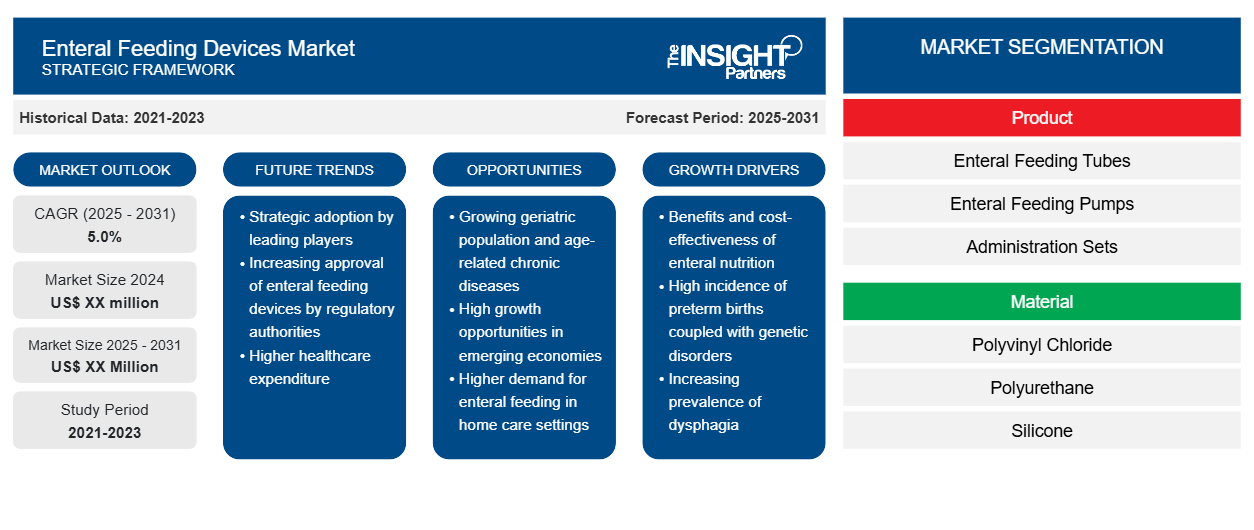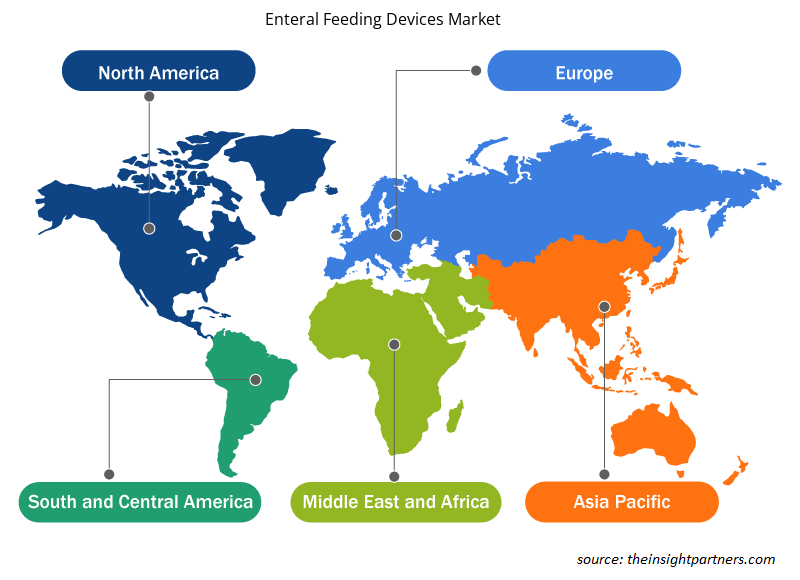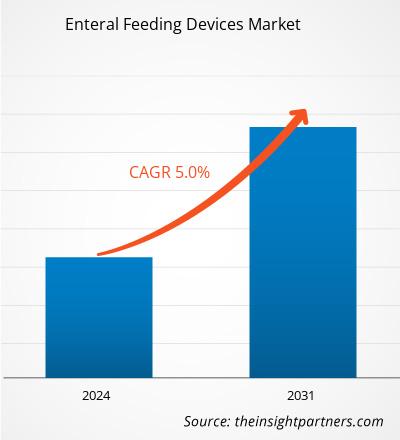The Enteral Feeding Devices Market is expected to register a CAGR of 5.0% from 2025 to 2031, with a market size expanding from US$ XX million in 2024 to US$ XX Million by 2031.
The report is segmented by Enteral Feeding Devices type ((Anxiety Disorders, Substance Abuse Disorders, Mood Disorder, Other). The report further presents analysis based on the Material [Polyvinyl Chloride (PVC), Polyurethane, and Silicone]. On the basis of Age Group (Pediatrics and Adults). On the basis of Application (Oncology, Gastrointestinal Diseases, Neurological Disorders, Diabetes, Hypermetabolism, and Other Applications). On the basis of End User (Hospitals, Ambulatory Surgical Center, and Home Care) The global analysis is further broken-down at regional level and major countries. The report offers the value in USD for the above analysis and segments.
Purpose of the Report
The report Enteral Feeding Devices Market by The Insight Partners aims to describe the present landscape and future growth, top driving factors, challenges, and opportunities. This will provide insights to various business stakeholders, such as:
- Technology Providers/Manufacturers: To understand the evolving market dynamics and know the potential growth opportunities, enabling them to make informed strategic decisions.
- Investors: To conduct a comprehensive trend analysis regarding the market growth rate, market financial projections, and opportunities that exist across the value chain.
- Regulatory bodies: To regulate policies and police activities in the market with the aim of minimizing abuse, preserving investor trust and confidence, and upholding the integrity and stability of the market.
Enteral Feeding Devices Market Segmentation
Product
- Enteral Feeding Tubes
- Enteral Feeding Pumps
- Administration Sets
- Enteral Syringes
- Consumables
Material
- Polyvinyl Chloride
- Polyurethane
- Silicone
Age Group
- Pediatrics
- Adults
Application
- Oncology
- Gastrointestinal Diseases
- Neurological Disorders
- Diabetes
- Hypermetabolism
- Other Applications
End User
- Hospitals
- Ambulatory Surgical Center
- Home Care
You will get customization on any report - free of charge - including parts of this report, or country-level analysis, Excel Data pack, as well as avail great offers and discounts for start-ups & universities
Enteral Feeding Devices Market: Strategic Insights

- Get Top Key Market Trends of this report.This FREE sample will include data analysis, ranging from market trends to estimates and forecasts.
Enteral Feeding Devices Market Growth Drivers
- Benefits and cost-effectiveness of enteral nutrition: It refers to providing nutrients directly into the gastrointestinal tract for patients who cannot consume and absorb nutrients from oral intake. The growth of markets in enteral nutrition has been attributed to multiple benefits and factors that are cost-effective. EN have better recovery rates in patients who are suffering from chronic conditions or those who are hospitalized when their nutritional status is maintained or even enhanced.
- High incidence of preterm births coupled with genetic disorders: The increasing number of preterm deliveries and genetic disorders in pediatric and neonatal patients is increasingly demanding enteral nutrition. Due to their low birth weight, these preterm babies have higher nutritional demands by virtue of their less developed organ systems. Thus, the needs for them have to be met using EN in an appropriate manner. For children with genetic disorders that interfere with digestion and absorption, EN can provide a better, more digestible form of nutrition as well as ensure their intake of basic nutrients.
- Increasing prevalence of dysphagia: Dysphagia is way more common among the elderly, primarily because it is due to age-related pathologies that include stroke, neurological diseases, and muscle weakness. It is this aging population that drives the demands for enteral nutrition solutions ever upward. Even Parkinson's disease, multiple sclerosis, and amyotrophic lateral sclerosis (ALS) usually bring about dysphagia, which requires nutrition therapy through EN. Thus boosting market growth
Enteral Feeding Devices Market Future Trends
- Strategic adoption by leading players: Companies continue to develop specific enteral nutrition products aimed at particular medical conditions, like renal and diabetic, as well as oncology-based needs. Improvements in feeding tubes and delivery devices are making it much easier to use and patients far more comfortable, with the added option for home care settings.
- Increasing approval of enteral feeding devices by regulatory authorities: Regulatory approval to be made for enteral feeding devices because the demand for safe and proper nutritional support arises prominently in the field, particularly in many ways-in-home care. Regulatory authorities are increasingly approving innovative feeding technologies that help realize superior patient outcomes with faster approvals granted for improved safety, usability, and efficiency of the devices. The tendency for regulatory authorities to approve enteral feeding devices is one of the major trends in the enteral nutrition market.
- Higher healthcare expenditure: As enteral nutrition grows in use in healthcare facilities as part of routine treatment for many diseases, spending on products and services associated with enteral nutrition increases. Much healthcare expenditure is another serious trend that faces the market, again a spillover effect of broad economic changes and health care goals.
Enteral Feeding Devices Market Opportunities
- Growing geriatric population and age-related chronic diseases: Older adults faces issues including decreased appetite, swallowing disorders (dysphagia), and malabsorption, making it challenging for them to maintain appropriate nutrition. The rapidly growing geriatric population and increasingly geriatric, age-related chronic disease will create vast opportunities in the enteral nutrition market
- High growth opportunities in emerging economies: As healthcare and delivery are changing in an aging population, nutrition is quickly becoming recognized as an integral part of holistic care and an increasing number of users of enteral nutrition. Rapidly growing geriatric population and prevalence of age-related chronic diseases present strong opportunities for the enteral nutrition market. The market will continue and take shape in innovation aimed at enhancing the health of the aged in those developing economies by specially addressing the nutritional requirements of this target population.
- Higher demand for enteral feeding in home care settings: Patient and family preferences for home care emanate from the comfort, familiarity, and the personalized environment enteral feeding provides, which would allow continuation of nutrition without frequent visits in a hospital. Increasing entitlements for enteral feeding in home care are dramatic opportunities for the enteral nutrition market.
Enteral Feeding Devices Market Regional Insights
The regional trends and factors influencing the Enteral Feeding Devices Market throughout the forecast period have been thoroughly explained by the analysts at The Insight Partners. This section also discusses Enteral Feeding Devices Market segments and geography across North America, Europe, Asia Pacific, Middle East and Africa, and South and Central America.

- Get the Regional Specific Data for Enteral Feeding Devices Market
Enteral Feeding Devices Market Report Scope
| Report Attribute | Details |
|---|---|
| Market size in 2024 | US$ XX million |
| Market Size by 2031 | US$ XX Million |
| Global CAGR (2025 - 2031) | 5.0% |
| Historical Data | 2021-2023 |
| Forecast period | 2025-2031 |
| Segments Covered |
By Product
|
| Regions and Countries Covered | North America
|
| Market leaders and key company profiles |
Enteral Feeding Devices Market Players Density: Understanding Its Impact on Business Dynamics
The Enteral Feeding Devices Market is growing rapidly, driven by increasing end-user demand due to factors such as evolving consumer preferences, technological advancements, and greater awareness of the product's benefits. As demand rises, businesses are expanding their offerings, innovating to meet consumer needs, and capitalizing on emerging trends, which further fuels market growth.
Market players density refers to the distribution of firms or companies operating within a particular market or industry. It indicates how many competitors (market players) are present in a given market space relative to its size or total market value.
Major Companies operating in the Enteral Feeding Devices Market are:
- Abbott
- B. Braun Melsungen AG
- Boston Scientific Corporation
- CARDINAL HEALTH
- Cook Medical LLC
Disclaimer: The companies listed above are not ranked in any particular order.

- Get the Enteral Feeding Devices Market top key players overview
Key Selling Points
- Comprehensive Coverage: The report comprehensively covers the analysis of products, services, types, and end users of the Enteral Feeding Devices Market, providing a holistic landscape.
- Expert Analysis: The report is compiled based on the in-depth understanding of industry experts and analysts.
- Up-to-date Information: The report assures business relevance due to its coverage of recent information and data trends.
- Customization Options: This report can be customized to cater to specific client requirements and suit the business strategies aptly.
The research report on the Enteral Feeding Devices Market can, therefore, help spearhead the trail of decoding and understanding the industry scenario and growth prospects. Although there can be a few valid concerns, the overall benefits of this report tend to outweigh the disadvantages.
Frequently Asked Questions
What is the expected CAGR of the Enteral Feeding Devices Market?
The Enteral Feeding Devices Market is estimated to witness a CAGR of 5.0% from 2023 to 2031
Which region accounted for the largest enteral feeding devices market share?
North America region accounted for the largest enteral feeding devices market share
What is the major challenges in the enteral feeding devices market?
Lack of awareness among the medical society about enteral feeding devices s the major challenges in the enteral feeding devices market
What is the year range for the market
2021 to 2022- are the historic year, 2023 - base year, 2024 to 2031- are the forecast year
What are the key players in the enteral feeding devices market?
Abbott Nutrition, ALCOR Scientific, Applied Medical Technology e the key players in the enteral feeding devices market
Which are the major Asia Pacific countries contributing in the enteral feeding devices market?
China, Japan, and India are the major Asia Pacific countries contributing in the enteral feeding devices market
- Historical Analysis (2 Years), Base Year, Forecast (7 Years) with CAGR
- PEST and SWOT Analysis
- Market Size Value / Volume - Global, Regional, Country
- Industry and Competitive Landscape
- Excel Dataset
Testimonials
Reason to Buy
- Informed Decision-Making
- Understanding Market Dynamics
- Competitive Analysis
- Identifying Emerging Markets
- Customer Insights
- Market Forecasts
- Risk Mitigation
- Boosting Operational Efficiency
- Strategic Planning
- Investment Justification
- Tracking Industry Innovations
- Aligning with Regulatory Trends
Yes! We provide a free sample of the report, which includes Report Scope (Table of Contents), report structure, and selected insights to help you assess the value of the full report. Please click on the "Download Sample" button or contact us to receive your copy.
Absolutely — analyst assistance is part of the package. You can connect with our analyst post-purchase to clarify report insights, methodology or discuss how the findings apply to your business needs.
Once your order is successfully placed, you will receive a confirmation email along with your invoice.
• For published reports: You’ll receive access to the report within 4–6 working hours via a secured email sent to your email.
• For upcoming reports: Your order will be recorded as a pre-booking. Our team will share the estimated release date and keep you informed of any updates. As soon as the report is published, it will be delivered to your registered email.
We offer customization options to align the report with your specific objectives. Whether you need deeper insights into a particular region, industry segment, competitor analysis, or data cut, our research team can tailor the report accordingly. Please share your requirements with us, and we’ll be happy to provide a customized proposal or scope.
The report is available in either PDF format or as an Excel dataset, depending on the license you choose.
The PDF version provides the full analysis and visuals in a ready-to-read format. The Excel dataset includes all underlying data tables for easy manipulation and further analysis.
Please review the license options at checkout or contact us to confirm which formats are included with your purchase.
Our payment process is fully secure and PCI-DSS compliant.
We use trusted and encrypted payment gateways to ensure that all transactions are protected with industry-standard SSL encryption. Your payment details are never stored on our servers and are handled securely by certified third-party processors.
You can make your purchase with confidence, knowing your personal and financial information is safe with us.
Yes, we do offer special pricing for bulk purchases.
If you're interested in purchasing multiple reports, we’re happy to provide a customized bundle offer or volume-based discount tailored to your needs. Please contact our sales team with the list of reports you’re considering, and we’ll share a personalized quote.
Yes, absolutely.
Our team is available to help you make an informed decision. Whether you have questions about the report’s scope, methodology, customization options, or which license suits you best, we’re here to assist. Please reach out to us at sales@theinsightpartners.com, and one of our representatives will get in touch promptly.
Yes, a billing invoice will be automatically generated and sent to your registered email upon successful completion of your purchase.
If you need the invoice in a specific format or require additional details (such as company name, GST, or VAT information), feel free to contact us, and we’ll be happy to assist.
Yes, certainly.
If you encounter any difficulties accessing or receiving your report, our support team is ready to assist you. Simply reach out to us via email or live chat with your order information, and we’ll ensure the issue is resolved quickly so you can access your report without interruption.















The List of Companies - Enteral Feeding Devices Market
- Abbott
- B. Braun Melsungen AG
- Boston Scientific Corporation
- CARDINAL HEALTH
- Cook Medical LLC
- Danone SA
- Fresenius Kabi AG
- Moog Inc
- Nestlé
- Owens & Minor, Inc.






 Get Free Sample For
Get Free Sample For